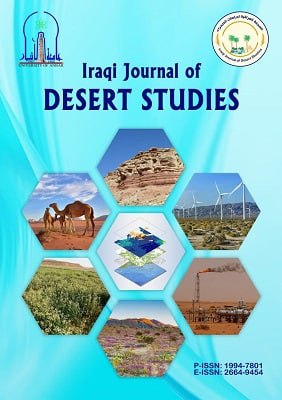Abstract
Two trials carried out one at laboratory and، second in field to study the activity of Rhizobium bacteria under the influence of variations of soil salinity on the growth of the plant Sesbania led the results of bacterial inoculation to an increase in the rate of plant height and the rate of dry weight and the number of formed on the roots of the plant Alcspan root ganglia and increase the readiness of the elements in the soil, especially nitrogen component. Results showed the superiority of the fertilized transactions for non-vaccinated transactions F1 and F2 in the nitrogen content in plant leaves Sesbania, with 3.042 and 2.785% recorded in the order and the results show that the vaccination a major role in increasing the number of effective root nodules formed on the roots of the plant, as was the number of nodes rate effective root formed on the inoculated plants F1,33.73 radical knots. -1 Plant, while the plants that did not add to it the vaccine F2 was 21.40 knots drastic effective. Plant -1. Showed laboratory tests for salinity there is clearly down in the preparation of bacteria Alraazoubia rate the higher the levels of salinity (EC), reaching the highest rate of the number of bacteria at the EC 2.19 dS.m-1 172 bacterial colony while the lowest number of bacteria is 6 colony when the salt level ( EC) dS.m-1 40 have attributed the decline in the number of bacteria increased salt levels to the direct effect of salinity and increased NaCl concentration increasing salinity. Increased concentrations of salt in the soil to reduce the activity Rhizobium and reduce the readiness of the elements and dry weight and the number of active root nodules formed on the plant Sesbania and the concentration of nitrogen, phosphorus and iron in the leaves and seeds.
Keywords
bacteria
bio-fertilization
Rhizobium
Salinity
Sesbania
Abstract
نفذت تجربتان إحداهما مختبرية والثانية احيائية لدراسة نشاط بكتريا الرايزوبيا تحت تأثير تغايرات ملوحة التربة في نمو نبات السيسبان أدت نتائج التلقيح البكتيري إلى زيادة في معدل ارتفاع النبات ومعدل الوزن الجاف وعدد العقد الجذرية المتكونة على جذور نبات السيسبان وزيادة جاهزية العناصر في التربة وخاصة عنصر النتروجين. اضهرت النتائج تفوق المعاملات الملقحة عن المعاملات غير الملقحة F1 و F2 في محتوى النتروجين في اوراق نبات السيسبان, إذ سجلت 3.042 و 2.785 % حسب الترتيب وتوضح النتائج ان للتلقيح دوراً كبيراً في زيادة عدد العقد الجذرية الفعالة المتكونة على جذور النبات ، إذ كان معدل عدد العقد الجذرية الفعالة المتكونة على النباتات الملقحة F1,33.73 عقدة جذرية . نبات-1 ، في حين النباتات التي لم يضاف اليها اللقاح F2 كانت 21.40 عقدة جذرية فعاله . نبات-1. وأظهرت الاختبارات المختبرية الخاصة بالملوحة هناك انحدار واضح في معدل اعداد بكتريا الرايزوبيا كلما زادت مستويات الملوحة (EC) أذ بلغ اعلى معدل لأعداد البكتريا عند EC 2.19 dS.m-1 172 مستعمرة بكتيرية في حين كان اقل عدد للبكتريا هو 6 مستعمرة عند المستوى الملحي(EC) dS.m-1 40 وقد يعزى هذا الانحدار في اعداد البكتريا بزيادة المستويات الملحية الى التأثير المباشر للملوحة وزيادة تركيز كلوريد الصوديوم بزيادة الملوحة. وأدت زيادة التراكيز الملحية في التربة الى تقليل نشاط الرايزوبيا وخفض جاهزية العناصر والوزن الجاف وعدد العقد الجذرية الفعالة المتكونة على نبات السيسبان وتركيز النتروجين والفسفور والحديد في الاوراق والبذور.
Keywords
الاسمدة الحيوية
البكتريا
الرايزوبيا
السيسبان
الملوحة
